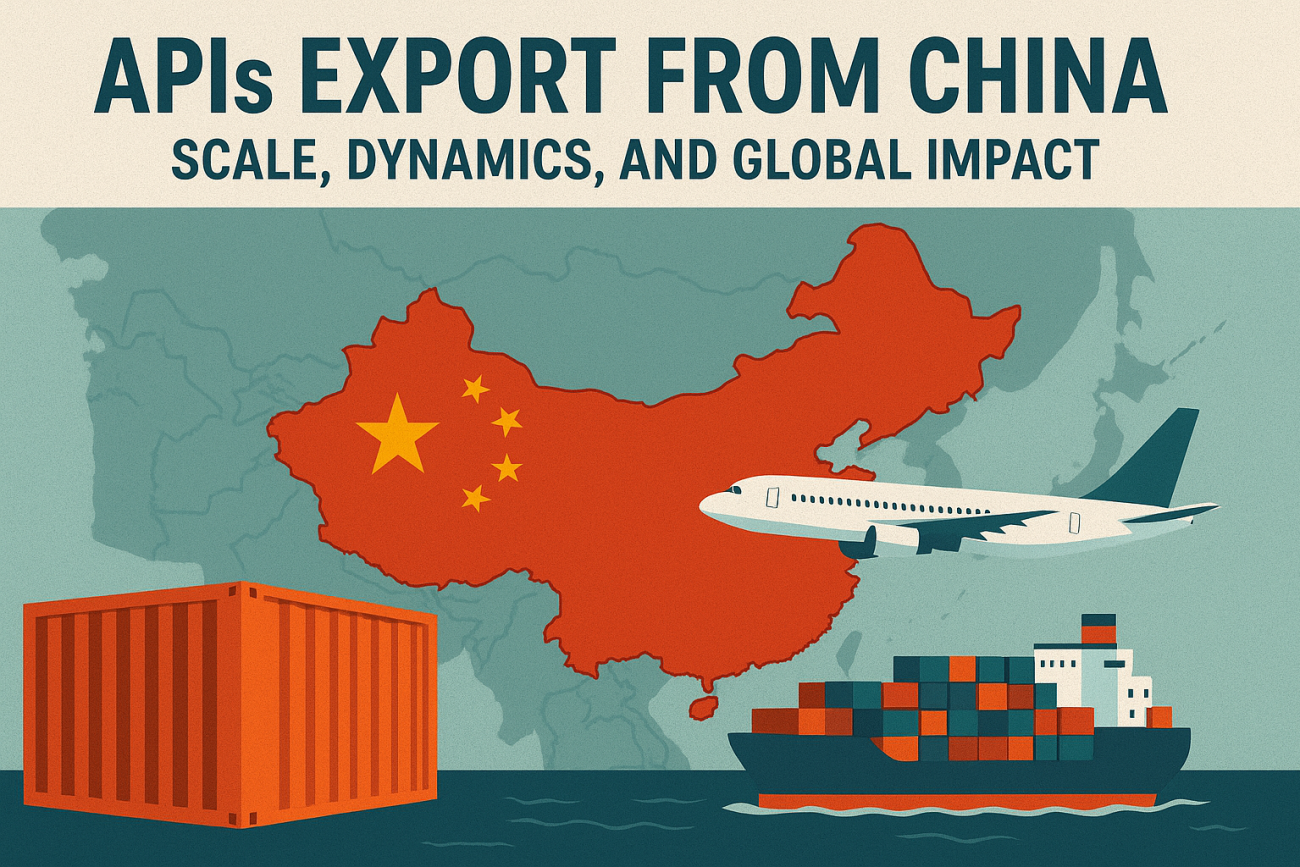1. Scope and Growth of China’s Drug Ingredient Exports
China has become a powerhouse in the global drug ingredients manufacturing industry. As of June 2025, it accounted for approximately 20 percent of global API production, supplying APIs to over 180 countries. The country’s cost structure—35% to 40% lower than many Western competitors—and increasingly advanced quality control systems have made it indispensable in global pharmaceutical supply chains
China’s production capacity is expansive: over 2 million tons per year, involving more than 2,000 unique drug ingredients. The industry features more than 1,500 manufacturers, including over 500 registered with the U.S. FDA
From a financial standpoint, China’s API market is projected to grow from US $15.9 billion in 2025 to $23.3 billion by 2030, reflecting a compound annual growth rate (CAGR) of 7.86%—well above global averages
2. Major Exported Ingredients & Therapeutic Categories
China’s strength lies especially in bulk APIs used in common medications:
-
Up to 95% of U.S. and EU-imported ibuprofen is made in China.
-
Approximately 70% of the world’s paracetamol (acetaminophen) originates from Chinese firms.
-
Over 80% of key antibiotic actives (e.g., doxycycline, amoxicillin) are produced in China.
-
More than 80% of metformin—a first-line treatment for type 2 diabetes—is China-made
These figures underscore China’s near-monopoly on foundational ingredients for analgesics, antipyretics, antibiotics, and diabetes medications—cornerstones of global healthcare.
3. Export Trends, Scale & Global Markets
China’s API export value surged between 2013 and 2022, from US $23.6 billion to $51.79 billion. In 2023, export volume rose by 5.4% to 12.489 million tons, while export value fell 20.6% to US $40.93 billion, largely due to post-pandemic demand reduction and competitive pricing
Market coverage is extensive—Chinese APIs reach nearly 200 countries and regions. Leading regions include the EU, India, ASEAN, and the U.S.. In 2023 alone:
-
EU accounted for 25.2% of China’s API exports,
-
India: 15.2%,
-
ASEAN: 10.5%,
-
U.S.: US $4.04 billion (–24.5% YoY)
Key markets:
-
EU: US $9.73 billion—top single region, with Germany, the Netherlands, Belgium, Italy, and Spain as main buyers
-
India: Imports of US $10.15 billion—68.8% of total Indian API imports, making China the dominant supplier
-
ASEAN: Imports rising amid declining imports from India and the U.S.; China’s exports there grew by 8% in 2023
4. Competitive Landscape & Specialty Ingredient Expansion
Traditionally, developed markets (Europe, the U.S.) led in high-value patented APIs, while China focused on mature bulk APIs. However, China is quickly entering the realm of specialty APIs through its growing CDMO sector and by garnering European certifications:
-
As of 2023, the EU Pharmacopoeia’s CEP certificates numbered 6,857; China holds about 18% of them
-
This enables Chinese firms to expand into specialized and higher-margin markets, narrowing the gap with Indian competitors
5. Regulatory and Environmental Hurdles in Manufacturing
The API industry in China is not without hurdles:
-
Environmental enforcement across industrial hubs like Hebei has led to closure of approximately 145 API manufacturers and impacted small-medium raw-material producers
-
Reduced competition has empowered remaining suppliers to hike API prices—creating short-term supply fragility and cost pressure
-
Government policies—such as supply-side reforms and price behaviour guidelines—promise improved structure, consolidation, and transition toward higher-value segments like specialty APIs or full preparations
6. Quality Standards, Regulation & Global Access
Perceptions of Chinese API quality have historically seen skepticism. Audits have revealed instances of substandard or fraudulent practices Pacific Bridge Medical. In response:
-
CFDA (China’s regulatory authority) has advanced new laws for API facility registration, risky excipient regulation, and has initiated a China Drug Master File (DMF) system.
International access demands compliance certifications:
-
EU’s CEP (Certification of Suitability) and
-
U.S. DMF (Drug Master File)
By Q1 2024, China had secured 3,539 DMFs, making up about 13.4% of U.S. total DMFs. Commitment to global regulatory standards (FDA, REACH) is helping Chinese exporters strengthen credibility.
7. Risks of Over-Reliance & Supply Chain Vulnerability
The nation’s dominance also introduces global fragility:
-
For critical antibiotics, the U.S. sources up to 36% of its API imports originating from the country —making shortages a real risk if trade is disrupted LinkedIn.
-
The concept of “at-risk APIs”—with few global suppliers—troubles supply chain planners. Diversification and contingency planning are essential
Conclusion
China is the fulcrum of the global API industry: cost-effective, vast-scale, and increasingly sophisticated. It underpins foundational global supply chains in healthcare, especially for everyday medications like analgesics, antipyretics, antibiotics, and diabetes treatments.
Yet with such reliance come challenges—regulatory scrutiny, environmental disruption, quality concerns, and geopolitical friction. China’s push toward specialty APIs, increasing global certifications, regulatory compliance, and industrial restructuring signal both resilience and ambition.
Going forward, pharmaceutical buyers worldwide must balance the benefits of China’s supply capacity with the necessity for supply chain diversification, quality assurance, and responsiveness to evolving global regulations.
Unlock China’s Expanding API Export Power — From Core Ingredients to Specialty Drug Compounds
Track leading API exporters, analyze price and volume trends, and identify certified suppliers across global markets.
Start your free trial today to transform real-time trade data into actionable sourcing intelligence.

